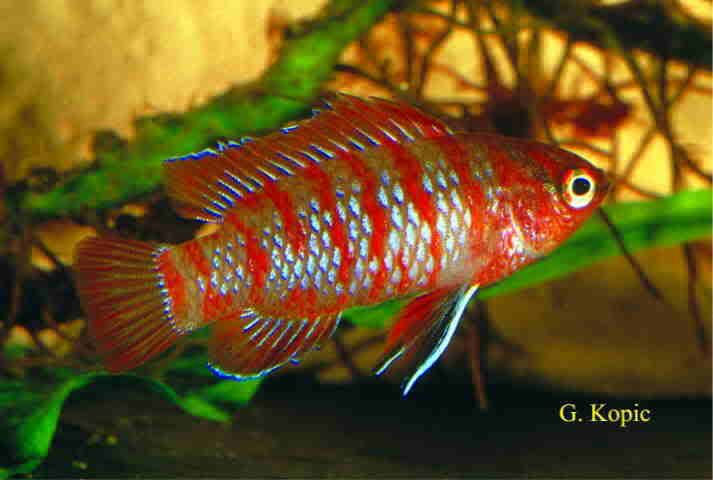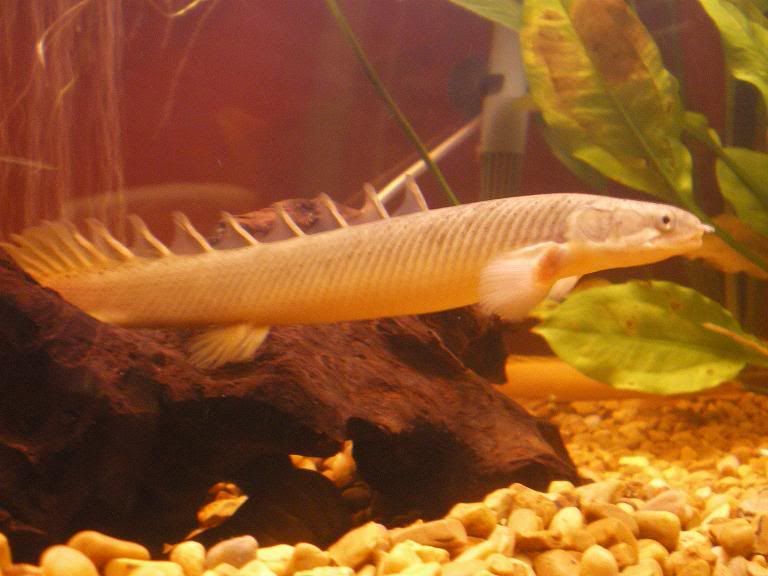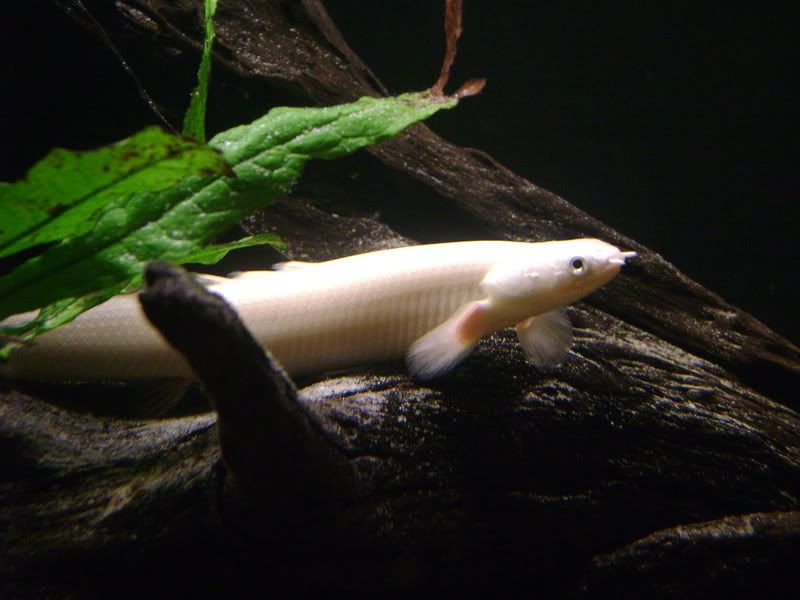i think so..
i'd like to refer you to the masters:
->https://www.istorya.net/forums/pet-di...iasts-ace.html
you're very much welcome in there..
hope it helps..
Results 111 to 120 of 193
-
02-19-2010, 10:27 PM #111
-
02-25-2010, 11:58 PM #112
Continuation of Fauna #31: Scarlet Badis

Family
Badidae
Distribution
Appears to be restricted to tributary systems draining into the Brahamaputra River in parts of West Bengal and Assam states, India although it may also range into Bhutan. When Hamilton described this species he did so without preserving any specimens, therefore to avoid confusion with similar-looking congeners Kullander and Britz (2002) designated a neotype which was collected from as close to the original type locality as possible, near the town of Raimana in western Assam. A 2004 phylogenetic study revealed that Dario from the Brahmaputra were probably separated from upper Ayeyarwady River species between 19-23 million years ago, resulting in the division of Dario dario and Myanmar/Chinese populations.
Habitat
Typically inhabits shallow, clear water streams with sand/gravel substrates and dense growths of marginal and/or aquatic vegetation. Plant species at one locality included members of Hygrophilia, Limnophila, Ottelia, Rotala and Vallisneria. At the type locality it was found living sympatrically with Badis blosyrus and B. kanabos.
Maximum Standard Length
Usually a little less then 0.8"/2cm for males and only around 0.5"/1.3cm for females; it is the smallest known percoid fish species.
Minimum Tank Size
A pair/single male with multiple females can be housed and will breed in a tank with dimensions of only 12" x 8" x 8"/30cm x 20cm x 20cm/12.5 litres although water quality may become an issue unless strictly monitored. We think something measuring around 18" x 10" x 10"/45cm x 20cm x 20cm/29.5 litres or more is preferable for long-term care.
Tank Setup
Dario dario will thrive in a heavily-planted set-up where the multitude of hiding places will provide it with the sense of security it needs to display natural behaviour. It will also appreciate the dimly-lit conditions towards the bottom of the tank where it will spend most of its time. A soft, sandy base is preferable although fine-grade gravel is acceptable and the substrate can even be omitted if you prefer, using plant species that can be grown attached to the decor such as Microsorum, Anubias or Taxiphyllum species. The latter is particularly important as it is an ideal spawning substrate for these fish. Driftwood branches, floating plants and leaf litter can all be added to lend a more natural feel while filtration and lighting need not be too strong.
Temperature
64.4 - 78°F/18 - 26°C
pH Range
6.5 - 8.5
Hardness
3 - 15°H
Diet
Dario species are micropredators feeding on small aquatic crustaceans, worms, insect larvae and other zooplankton. They can be a little picky in the aquarium and may not accept dried foods although in some cases they will learn to take them over time. At any rate they should always be offered regular meals of small live or frozen fare such as Artemia nauplii, Daphnia, grindal, micro and chopped bloodworm in order to develop ideal colour and conditioning. They are noted as somewhat shy, deliberate feeders (see 'compatibility').
Compatibility
Can be kept in a community tank provided tankmates are chosen with care. It is slow-moving with a retiring nature and may be intimidated or outcompeted for food by larger/more boisterous tankmates. Peaceful cyprinids such as Boraras, Trigonostigma or smaller Rasbora species make good choices and we suspect it will also do ok with many South American characins, Otocinclus and similar small Loricariids or pygmy Corydoras catfish. Accommodating it in a biotope-style community of fish from the West Bengal/Assam region is trickier although suitable species available in the trade include Puntius gelius , P. phutunio and Colisa chuna . It should also do well alongside Indian Danionella species if you are lucky enough to find any which would make an interesting combination. Certainly do not combine it with similar-looking, territorial bottom dwellers such as dwarf cichlids unless the tank is very large and never house it with other Dario species as hybridisation might occur. While adults may be left unharmed young of the popular Caridina and Neocaridina shrimp species will probably be eaten.
It is not a gregarious fish as such and rival males can be aggressive towards one another, especially in smaller tanks. In these cases only a single pair or one male and several females should be purchased but in roomier surroundings a group can coexist provided there is space for each male to establish a territory and plenty of broken lines of sight.
Sexual Dimorphism
This species is very easy to *** but often only males are imported for the trade, presumably for their brighter colours. Females are smaller, have duller patterning (they do not possess any red or blue colouration on the flanks) and a noticeably shorter, rounder-looking body profile then males. Males also develop extended pelvic fins as they mature.
Breeding
Members of this genus are substrate spawners that form temporary pair bonds and are not usually too difficult to breed provided the tank is arranged correctly (see 'tank set-up'). Other species are best omitted if you want to raise good numbers of fry although in a mature, well-furnished community a few may survive to adulthood. Either a single pair or a group of adults can be used but if using multiple males be sure to provide each with space to form a territory; around 12" x 12" per individual should be adequate. Set water parameters within the values suggested above, feed the fish with plenty of live and frozen foods and spawning should not present too many problems. Setting the temperature towards the upper end of the suggested range may also help.
As they come into breeding condition males will begin to form territories and display courtship behaviour towards females swimming nearby. During this process they display some wonderful changes in patterning with the body intensifying in colour. No real aggression is displayed and a receptive female will simply follow the male to the centre of the territory where spawning takes place in an embrace similar to that seen in anabantoids. The eggs are laid and fertilised in a random fashion rather than being placed deliberately but most tend to fall in the same general area, with an average brood numbering 70-100.
Post-spawning the female is ejected and the male takes sole responsibility for the territory, defending it against intruders and patrolling tirelessly. If you want to maximise the numbers of fry raised now is the time to remove either the medium (to a container containing water from the spawning tank) or the adult fish although normally some will survive even if everything is left in situ. The eggs should hatch in 2-3 days after which the fry may need up to a week to fully absorb the yolk sac. They are very small indeed and will require an infusoria-type diet until large enough to accept microworm and/or Artemia nauplii.
-
02-28-2010, 01:04 PM #113
-
07-02-2010, 11:16 PM #114
OW! nice thread!!!
 I was browsing for Aquatic plants... niabot lang kog kalit dini sa istorya haha... up ko ani! bahalag wa nako nakita akong gipangita dini... natana koy gina ID nga moss kay wa jud ko kaila... and a grass...
I was browsing for Aquatic plants... niabot lang kog kalit dini sa istorya haha... up ko ani! bahalag wa nako nakita akong gipangita dini... natana koy gina ID nga moss kay wa jud ko kaila... and a grass...
The info about cabombas helped me... unsay difference between Whorled Pennywort ( HydrHydrocotyle verticillata) and gotu kola (Centella asiatica) mga sir?
ok ra pud mo post ug other fauna species aside from the ones in your list sir gaevwa? like bichirs and other anthropods?
-
07-03-2010, 11:37 AM #115
Fauna # 67: Senegal Bichir

Normal Senegal Bichir
Common Name: Senegal Bichir, Cuvier's Bichir, Dinosaur Eel, Gray Bichir, Dragonfin, Sailfin
Scientific Name: Polypterus senegalus
Local Name: Most people call it Dragonfin,
Origin: Africa’s rivers and lakes e.g. Central Africa, Lake Albert, Rudolph and Chad also found in Gambia, Niger and Senegal.
Life Span: 12 years or more, depending on how well it is cared for.
Temperament: Peaceful
Tank Compatibility Issue (for both Flora and Fauna): The Senegal Bichir should be kept in a densely planted aquarium with rocks, driftwood, and a soft substrate. A community aquarium with larger fish is well suited for this fish as long as the aquarium is large enough and not overcrowded. Overcrowding with other fish or other Senegal Bichirs may cause this fish to become territorial, aggressive, and eat other fish. It tends to escape from the aquarium, so use a tight-fitting lid.
Freshwater/Brackish/Marine: Freshwater
Water pH: ideally 6.5 - 7
Water Hardness: (dGH): 4 - 18 °N, fairly soft
Temperature: 77°F to 89°F (25 to 28°C)
Schooling/Non-schooling: Non-Schooling
Common Illness/Problems: They have spiral valves and may be sensitive to chitinous foods/feeders (e.g. superworms). They are big-time jumpers and could die or have spinal fractures once they escape from the tank.
Growth: May reach adult size in a year.
Length/Size: about 50cm (19.5 inches). Maximum size in aquariums (min-max): 20 - 30 cm ( 7.87 - 11.81 in )
Difficulty: Easy
Water Current/Movement Issues:
General Description: Senegal Bichir is also known as the dinosaur eel because of its elongated, eel-like body and its serrated dorsal fin that is dinosaur-like. This species, however, is not a true eel. The small pectoral fins of the Senegal Bichir only allow this fish to swim slowly, preventing it from being a better predator. A modified swim bladder gives the Senegal Bichir the ability to breathe atmospheric oxygen.
Other Important Information: They have a highly developed sense of smell and will know as soon as food is added to the tank. They can be territorial to each other, but if they have their own space this will be minimized. They can be kept with other medium to large sized non aggressive fish. They have a reputation as being great escape artists and can move on land for short lengths, so take proper precautions with your tank cover.

Platinum Senegal Bichir

Albino Senegal Bichir
MORE BICHIRS:
ornate bichir (Polypterus ornatipinnis)
armored bichir (Polypterus delhezi)
marbled bichir (Polypterus palmas polli)
Weeks' bichir (Polypterus weeksii)
Zaire green (Polypterus retropinnis, formerly "Polypterus sp. Zaire green")
lapradei bichir (Polypterus bichir lapradei)
Polypterus bichir bichir
tiger bichir (Polypterus endlicheri endlicheri)
Congo bichir (Polypterus endlicheri congicus)
Polypterus ansorgii
...
References:
Cuvier's Bichir - Polypterus senegalus
Senegal (Cuvier's) Bichir, by Joe Gallo
Polypterus senegalus (Senegal bichir)
The Senegal Bichir, Polypterus senegalus Profile, with care, maintenance requirements and breeding information for your tropical fish
Senegal Bichir - Polypterus SenegalusLast edited by scorpia; 07-03-2010 at 11:59 AM.
-
07-03-2010, 12:18 PM #116
well, no.. hehe I just like to research n post here, kasi gus2 ku mka learn @ the same time ma share nako dreh.. sayang kasi hindi na active tong thread n2, also, I have my thread to attend to sa sicence section

ENDEMIC SPECIES of the Philippines
hehe
-
07-03-2010, 12:28 PM #117
-
07-04-2010, 12:30 AM #118
hi guys, thanks to you, ni-Up balik ako thread.. wala naman kaayo ko'y sulod2x sa istorya ron and i was just prompted sa email notification nga naa diay ni-post diria..hehe.. thanks kaayo guys.. post2x lang mo kay para ra man sad ni sa tanan..

@moi: thanks for watching over this thread..
@scorpia: thanks for visiting and contributing to this thread.. member na ka sa ACE ma'am? if not yet, i recommend you visit their thread..
if dili nako busy sa work, basin maka-balik ra ko diria..thanks once again...
-
07-04-2010, 11:20 AM #119
@sir gaevwa: haha good to see you again sir...
dili ko member sa ACE... sa PAHLS ko naka join before but gitapulan nakog visit kay medyo di ayo ko ganahan sa aura sa mga tao didto... I'm planing to join the club sa davao kay mas duol haha and naman chapter samo location... I have visited the ACE site but la pako ka join...
I'll try to contribute more sometime to thisthread... sayang man pud gud imo hago sir and sa uban pud labaw na kay moy1moy1 if mawala ni... ^^
-
07-06-2010, 07:40 AM #120
Advertisement
Similar Threads |
|






 Reply With Quote
Reply With Quote ) dili ba mag-basking kining newts? the lamp is more useful also if mag-basking sila..
) dili ba mag-basking kining newts? the lamp is more useful also if mag-basking sila..
 lagi, I just checked out the date of his last post... dili najud active... btw, are you a PALHS member too, sir moy1moy1?
lagi, I just checked out the date of his last post... dili najud active... btw, are you a PALHS member too, sir moy1moy1?
